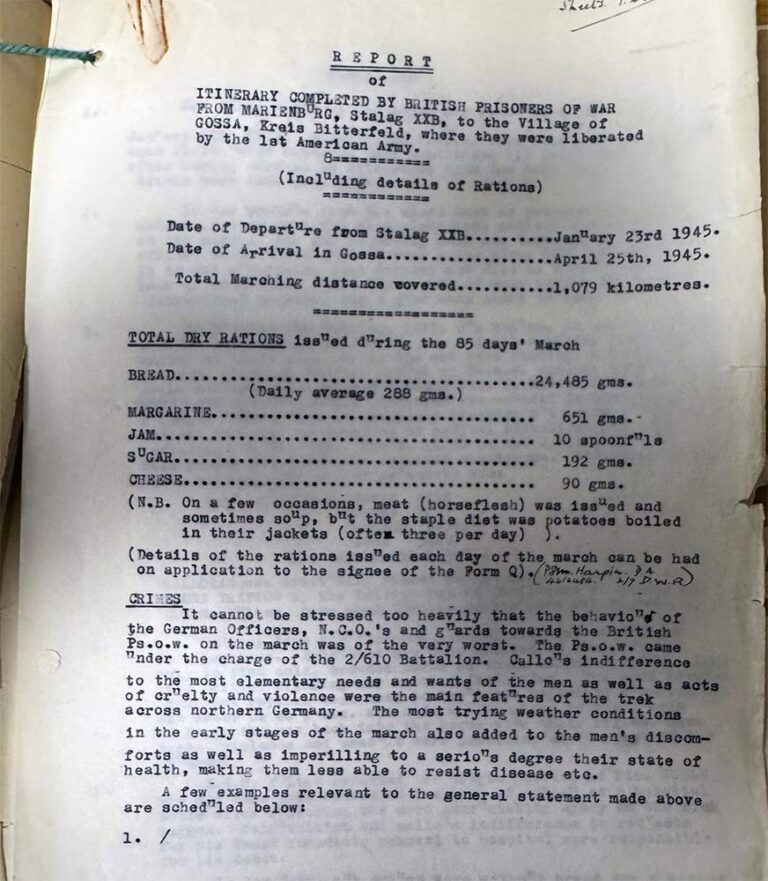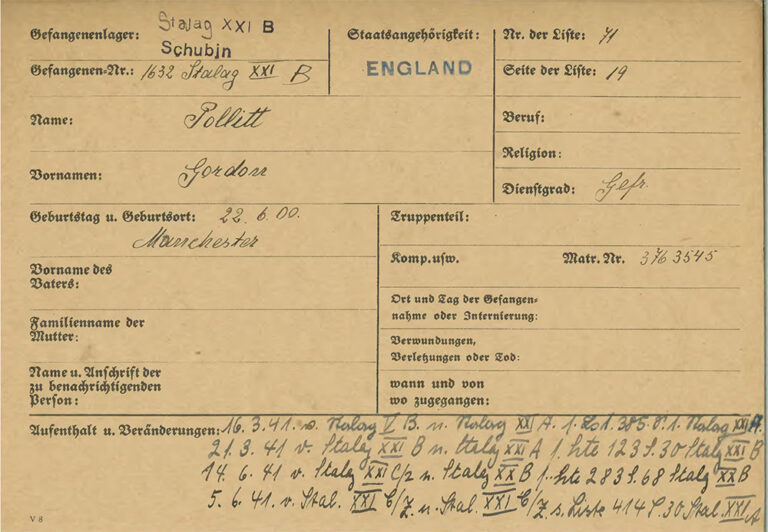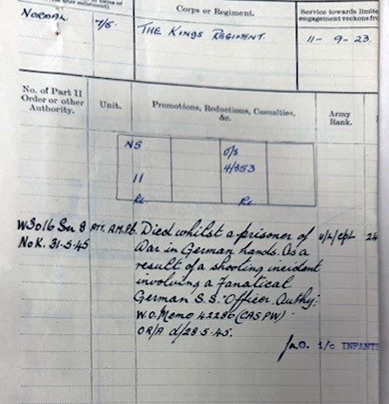Content note: This blog includes documents that describe the inhumane treatment of prisoners of war at the end of the Second World War.
‘The Great March West’, ‘The Long March’, ‘The Long Walk’, ‘The Long Trek’, ‘The Black March’, ‘The Bread March’, and ‘Death March Across Germany’ are a variety of terms used to describe a series of forced prisoner of war marches that took place 80 years ago during the final stages of the Second World War in Europe.
From a total of 257,000 Allied prisoners of war (POWs) held in German POW camps, over 80,000 were forced to march westward, away from the advancing Soviet Army, across Poland, Czechoslovakia and Germany in extreme winter conditions, over about four months between January and April 1945.
Dire circumstances
Many POWs began their marches in awful conditions: some had malnutrition and most were simply too weak to endure such a strenuous journey. A lot of the marches became notorious, such as the one from Stalag Luft IV in Pomerania, where the POWs faced an 800 km (500 mile) trek in blizzard conditions across Germany, during which hundreds died.
The winter of 1944–45 was especially harsh, and during January and February 1945 those on the march had to endure heavy snowfall, ice and sub-zero temperatures day and night.
Red Cross parcels, which had been issued to men before the march, soon ran out, leaving them with meagre rations distributed by the Germans. Contaminated water led to instances of dysentery and diarrhoea and many men soon became physically unable to march. Coupled with this was the problem of Allied fighter aircraft roaming German occupied territory and mistaking long rows of marching POWs as enemy military personnel.
Stalag Luft III
One of the most notorious marches was from Stalag Luft III, the location of The Great Escape where 76 POWs had escaped on the night of 24/25 March 1944, though 73 would be recaptured within days. Situated in Sagan, now in modern-day Poland, the camp was evacuated on 27 January 1945 as the Soviet forces advanced.
An account in WO 311/202 by Albert A Kadler, a Swiss observer, reports how bitterly cold it was. The march involved some 2,300 men. The first night involved staying at Freiwaldau, some 26 km from Sagan. There was only accommodation for a third of the men, so the majority would spend the night outside in the bitterly cold weather with the little food provided by the Red Cross. The following day, they marched at a temperature of minus 20 degrees, and in strong winds with few breaks, to Muskau, which was another 35 km away. The march would end in Nurnberg-Langwasser on 4 February.

Stalag XXB
Another account, this time of the march of 3,000 POWs from Stalag XXB, Marienburg, to Gossa, Kreis Bitterfel, in WO 311/214, records the death of Private Loweson (POW number 16929). He died at Schwadwalde on 15 April 1945 of dysentery and malnutrition. He had been waiting for admission to hospital for at least a week.
The account reads, ‘The German authorities would not allow us to bury him and we were compelled to carry his body into a garage and leave it there’.
The march would cover 1,079 km and take just over three months with meagre rations, and the men were subject to acts of cruelty and violence from their captors.

Lance Corporal Gordon Pollitt of the Kings’ Regiment died on the Long March from Stalag XXIB in Schubin, Poland. His service record, WO 423/460101, records that he died ‘as a result of a shooting incident involving a fanatical German SS Officer’. He was 40 years old.


After the war many Germans were investigated and prosecuted for offences committed in all theatres of the Second World War, including ill-treatment, often resulting in deaths. Many of these files relate to horrendous conditions endured during the Long March.
Find out more
Many of the record series referred to in this blog have been subject to in-depth cataloguing by volunteers at The National Archives. We have created a bespoke search tool, for many of these, covering multiple series, to make searching for POW records in our catalogue by name easier. Search either by surname only, by surname plus initial/s or by surname and forename/s (try all three alternately as different combinations may return different results).
Some of the POWs did attempt and sometimes succeed in escaping on the March. At the end of the March the remaining POWs were liberated by the American Army. See also the records in FO 950 (Nazi persecution claims files).
Hello
What about the the stalag XXA in Thorn ?
They did the march, or they have been delivered by the Russian troops.
thanks